
Sin is a first-person shooter video game developed by Ritual Entertainment and published by Activision in 1998. It uses a modified version of the Quake II engine. Sin is set in the dystopian future of 2037, where John Blade, a commander in a security force named HardCorps in the megacity of Freeport, is tasked to rid the city of a recreational drug that may be tied to the rival biotechnology megacorporation, SinTek.

Icewind Dale is a role-playing video game developed by Black Isle Studios and originally published by Interplay Entertainment for Windows in 2000 and by MacPlay for the Macintosh in 2002. The game takes place in the Dungeons & Dragons Forgotten Realms campaign setting and the region of Icewind Dale, and uses the 2nd edition ruleset. The story follows a different set of events than those of R. A. Salvatore's The Icewind Dale Trilogy novels: in the game, an adventuring party becomes enlisted as a caravan guard while in Icewind Dale, in the wake of strange events, and eventually discover a plot that threatens the Ten Towns of Icewind Dale and beyond.

Earth 2150, also known as Earth 2150: Escape from the Blue Planet, is a real-time strategy game, originally published in 2000 by SSI and Polish developer Reality Pump and a sequel to Earth 2140. 2150 was one of the first commercial full-3D games of its kind. A sequel to Earth 2150, Earth 2160, was published in August 2005. The game also has two stand-alone expansion packs: Earth 2150: The Moon Project, and Earth 2150: Lost Souls.

Age of Wonders is a 1999 turn-based strategy game co-developed by Triumph Studios and Epic MegaGames, and published by Gathering of Developers.

Ground Control is a real-time tactics video game developed by Massive Entertainment and published by Sierra Studios. It was first released onto the PC Microsoft Windows in 2000. The game focuses on a conflict between two factions vying for control of a planet and a series of alien artefacts contained on its surface, in which players take the role of an officer for each faction, working to achieve their objectives through using a variety of futuristic style of troops, engaging different tactics that make use of their units, the terrain and careful planning.
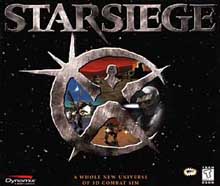
Starsiege is a mecha-style vehicle simulation game developed by Dynamix and released in 1999. Starsiege is set in the Metaltech/Earthsiege universe, which contains its predecessors Earthsiege (1994), Battledrome (1994), and Earthsiege 2 (1996). This universe also includes action game Hunter Hunted (1996), strategy games Mission Force: Cyberstorm (1996) and Cyberstorm 2: Corporate Wars (1998). It also includes the sequelsStarsiege: Tribes and all subsequent Tribes titles. In 2015, this game and the rest of the Metaltech/Tribes series were released as freeware by Hi-Rez Studios, but Battledrome and the Cyberstorm series were not.

Battlezone is a first-person shooter real-time strategy video game, developed and published by Activision. It was released for Microsoft Windows in 1998. Aside from the name and presence of tanks, this game bears little resemblance to the original arcade game of the same name. Activision remade it into a hybrid of a tank simulation game, a first-person shooter and a real-time strategy game. In Battlezone the player is controlling everything on the battlefield from the first person view.

Dark Reign: The Future of War is a real-time strategy video game for Microsoft Windows, developed by Auran and published by Activision in 1997. The game consists of a large single-player campaign but also supports multiplayer online games. A mission construction kit is included with the game, which allows players to create new maps for multiplayer games and create entire missions and campaigns.
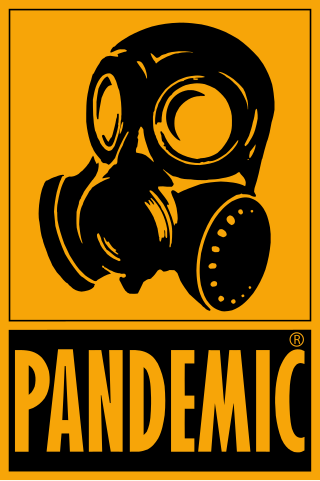
Pandemic Studios, LLC was an American video game developer based in Westwood, Los Angeles. Andrew Goldman and Josh Resnick founded the studio in 1998 after leaving Activision. Pandemic Studios, alongside BioWare, was acquired in 2005 by Elevation Partners and placed under VG Holding Corp., which in 2007 was sold to Electronic Arts (EA). EA closed Pandemic Studios in 2009. Pandemic Studios is known for a variety of titles, including Full Spectrum Warrior, Star Wars: Battlefront, Dark Reign 2, Destroy All Humans!, Mercenaries, and The Saboteur.

Tachyon: The Fringe is a Space combat simulation video game developed and published in 2000 by Novalogic. It features the voice acting of Bruce Campbell as main character Jake Logan in a 3-D space simulator. Tachyon was developed by Randy Casey, who had previously written two other titles for Novalogic: F-22 Lightning II and F-22 Raptor.
An internet leak is the unauthorized release of information over the internet. Various types of information and data can be, and have been, "leaked" to the Internet, the most common being personal information, computer software and source code, and artistic works such as books or albums. For example, a musical album is leaked if it has been made available to the public on the Internet before its official release date.

Lords of Magic is a turn-based strategy Microsoft Windows game designed for Windows 95/98 by Sierra On-Line. The game was intended to combine elements of Heroes of Might and Magic II and Lords of the Realm II. The special edition also contains the Legends of Urak quest pack, a set of five individual quests that revolve around stories unrelated to the main plot of the game.

MechWarrior 3 is a vehicle simulation game, part of the MechWarrior series. It featured a new 3D accelerated graphics engine at the time of its release. The game contains over 20 missions, with access to 18 different mechs. A novelization called Trial Under Fire was written by Loren L. Coleman.
Major and recurring characters from the military science fiction series StarCraft are listed below, organised by respective species and most commonly affiliated faction within the fictional universe. The story of the StarCraft series revolves around interstellar affairs in a distant sector of the galaxy, where three species are vying for supremacy: the Terrans, a highly factionalised future version of humanity; the Protoss, a theocratic race of vast psionic ability; and the Zerg, an insectoid species commanded by a hive mind persona. The latter two of these species were genetically engineered by the Xel'Naga, a fourth species believed extinct. The series was begun with Blizzard Entertainment's 1998 video game StarCraft, and has been expanded with sequels Insurrection, Retribution, Brood War, Ghost, Wings of Liberty, Heart of the Swarm, and Legacy of the Void. The franchise has been further extended with a series of novels, graphic novels, and other works.

Transformers: Revenge of the Fallen is a third-person shooter video game based on the 2009 live action film Transformers: Revenge of the Fallen. It is the sequel to 2007's Transformers: The Game, and the second video game adaptation of the live-action Transformers film series. The PlayStation 3 and Xbox 360 versions of the game were developed by Luxoflux, and ported to Microsoft Windows by Beenox. The PlayStation 2 and Wii versions were developed by Krome Studios, and the PlayStation Portable version was developed by Savage Entertainment. All versions of the game were published by Activision, and released on June 23, 2009 in the United States. Australia received the games one day later, and Europe on June 26. A sequel, Transformers: Dark of the Moon, was released in June 2011, based on the film on the same name.
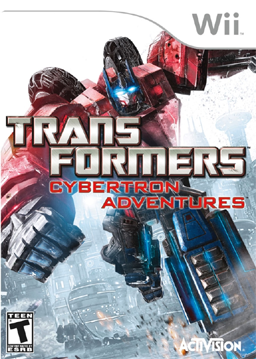
Transformers: Cybertron Adventures is an action-adventure video game based on the Transformers franchise, developed by Next Level Games and published by Activision. It is a companion game to High Moon Studios' Transformers: War for Cybertron, released exclusively for the Wii in June 2010. Like War for Cybertron, it features separate campaigns for the Autobots and the Decepticons, with the player being able to choose either faction to play as. The game received mixed to negative reviews from critics.
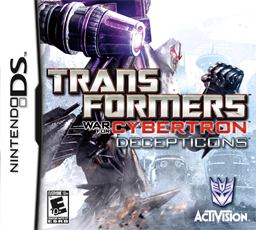
Transformers: War for Cybertron - Autobots and Transformers: War for Cybertron - Decepticons are two action-adventure video games based on the Transformers franchise, published by Activision in June 2010. A port of High Moon Studios' Transformers: War for Cybertron for the Nintendo DS, they were developed by Vicarious Visions, who also worked on Transformers Autobots and Transformers Decepticons in 2007, and Transformers Revenge of the Fallen: Autobots and Transformers Revenge of the Fallen: Decepticons in 2009. Although they share some basic similarities, the two games follow different storylines, and feature different characters, missions, and locations.
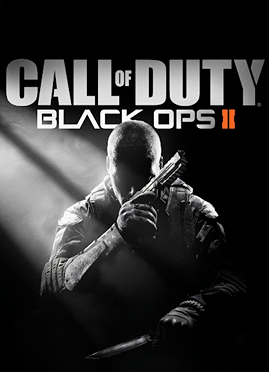
Call of Duty: Black Ops II is a 2012 first-person shooter video game developed by Treyarch and published by Activision. It was released for Microsoft Windows, PlayStation 3, and Xbox 360 on November 12, 2012, and for the Wii U on November 18 in North America and November 30 in PAL regions. Black Ops II is the ninth game in the Call of Duty franchise of video games, a sequel to the 2010 game Call of Duty: Black Ops and the first Call of Duty game for the Wii U. A corresponding game for the PlayStation Vita, Call of Duty: Black Ops: Declassified, was developed by nStigate Games and also released on November 13.

Heavy Gear II is a mecha based first-person shooter video game. Set in Dream Pod 9's Heavy Gear universe, the game was developed and published by Activision in 1999 for Microsoft Windows; it was ported to Linux in 2000 by Loki Software. It is a sequel to the 1997 video game Heavy Gear.

Destiny 2: Shadowkeep is a major expansion for Destiny 2, a first-person shooter video game developed by Bungie. Representing the fourth expansion and the third year of extended content for Destiny 2, it was released on October 1, 2019, and was the first major expansion to be published independently by Bungie after acquiring publishing rights for the series from Activision in early 2019, as well as the first to arrive on Steam rather than the Battle.net client which had been used since Destiny 2's launch. The expansion returns players to Earth's Moon as a playable destination, with the location reprised and expanded upon from the original version of the first Destiny game. The story sees the return of Eris Morn, who had been absent since the events of Destiny 2's original base campaign. Eris seeks the help of the Guardian in defeating "Nightmares" that she released into the Solar System, which are manifestations of the Guardian's past. Players face off against their previous adversaries, which are being resurrected by the Darkness, the ancient enemy of the Traveler. Throughout the story, Eris and the Guardian work together to figure out the cause of this unleashed madness and do what they can to put a stop to it. Shadowkeep includes new content for every aspect of the game; including new missions, new Player versus Environment (PvE) locations, Player versus Player (PvP) maps, weapons, armor, exotic gear, a new dungeon, a new raid, as well as further fundamental changes to the core functionality of the game, including a revamped armor system.


















